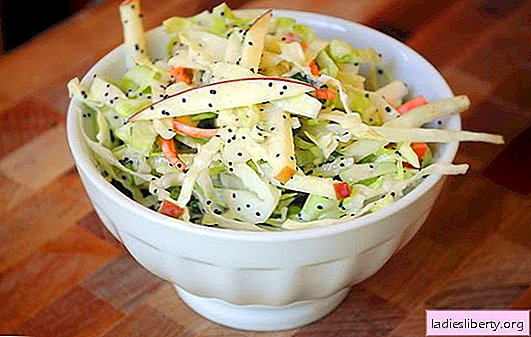
Under the name "Red Fish", usually understand the fish of the salmon family.
It belongs to delicious varieties and not surprisingly, large fish with a high fat content in the pulp are really very tasty.
The fish of these breeds is used in various dishes, but one of the most popular in our country is the supply of red fish in the form of various pickles.
However, Russia is not only rich in salmon, but the skill of our fishermen is not inferior to the ingenuity of our cooks.
You can pickle almost any ocean fish so that you can’t figure out which is better - capelin, or pink salmon.
Salting fish at home - the basic principles of preparation
• For self-salting fish at home, both fresh and frozen are ideal, it is advisable to choose fish with intact skin.
• Frozen carcasses are thawed using prolonged defrosting - in the “warm” chamber of the refrigerator, or in a bowl dipped in a basin of cold water.
• Scales are removed from fresh or thawed carcasses, fins are cut, the abdomen is cut, and gently gutted. After thoroughly washed and proceed to cutting.
• Salt for salting is taken as large as possible, boiling out, Extra grades, will not work. Also, do not use iodized salt, in iodine fish there is enough iodine and no additives.
• Fish is salted using the "dry" method, in marinades and even with the help of pickles.
• The most "favorite" spices of fish - cumin, coriander, white pepper and lavrushka. The rest are already related to refinements and it is better to use them carefully, at your discretion.
Salting fish at home - dry salted salmon
Ingredients:
• salmon, filet or gutted carcass;
• coarse salt;
• granulated sugar;
• spicy spices - cumin and coriander, dry seeds.
Cooking method:
1. If there is a boneless filet, then immediately cut it into large slices. The carcass must be carefully cut - cut with a thin, narrow, very sharp knife from the peritoneum, along the ridge. Peritoneal bones - “ribs” are also cut off at their discretion, or they are left for fans of their own “disassembly”. Halves of fish are cut into large slices, having previously cut off the skin with scales. You can leave, but then you have to tinker, cleaning and washing off the scales at the end of pickling.
2. Grind the spices in a porcelain mortar, or quickly, not in flour, grind with a coffee grinder. A spice mill is also suitable if it does not turn them into powder.
3. Salt and sugar are mixed in a 2: 1 ratio, three full, “with a hill”, tablespoons of such a mixture are taken per kilo of fish.
4. Spice enough 1 teaspoon. They should not be abused; red fish is already so tasty; there is no need to interrupt a specific taste, as in the cases with capelin or herring.
5. Sprinkle chunks of fish with a mixture of salt, spices and sugar and arrange them on a clean cotton or linen rag. Its dimensions should allow tight wrapping of fillets at least twice.
6. Wrap the pieces of fish with a cloth as tight as possible without damaging the meat. We put the blanks in a voluminous pan under the lid and put it in the refrigerator.
7. At least two, and preferably 3-4 times a day, remove the pieces of fish from the pan and shift them in a random order, the released moisture in the mixture with salt will soak the various pieces more intensely.
8. On the third day put a small “oppression” - a jar of water, depending on the number of fish, 1 or 3 liter. Soak the fish for about 12 hours for complete salting. Salmon is ready, you can alternately choose pieces as needed. If you do not quickly consume everything, lower the temperature in the refrigerator.
Salting of red fish at home - "Fishery reserve"
Ingredients:
• carcass of pink salmon, or other red fish, better gutted, without a head;
• salt is large, not boiling out;
• granulated sugar;
• allspice, fresh large parsley.
Cooking method:
1. If the carcass is whole, separate the head, carefully remove the contents of the peritoneum through the hole, slowly and rinse with cold water. Cut the tail to the level of the anus.
2. Along the back, trying to get as close to the ridge as possible, cut to the abdomen, remove the ridge, helping, if necessary, with a knife.
3. Wipe dry with a napkin and cover the side of the pulp with a thick, about 5 mm thick layer of coarse salt. Squeeze with a flat load, such as a cutting board, or a brazier and put on top something weighty, a jar or a pot of water.
4. We stand for 40 minutes and carefully scrub the salt with a knife, wipe with a dry rag. The salt will have to be thrown away.
5. Prepare a mixture of sugar and salt in a ratio of 2: 0.8. Crush into large pieces allspice. We wash the parsley and take it apart, removing all the stems and leaving only the leaves.
6. Salt one half of the “deployed” carcass on the inside, at the rate of 3 tablespoons of the mixture to one kilogram of fillet. Lay a parsley over the salt and cover with the second half of the peritoneum. It will turn out like a whole fish.
7. At the bottom of a wide salting dish, sprinkle fragrant pepper and put small fish on it, with "upper" sides. This refers to the side to which the parsley layer is touching from the inside, and not the salt layer. In this form, the fish should lie down for 5 to 8 hours, the larger the carcass - the longer.
8. Turn the fish upside down and put them in the refrigerator for a day.
9. After a day, we remove the parsley from the abdomen and replace it with fresh. Further, the whole trick of salting is to turn the fish from side to side at least every 12 hours.
10. Salts such a fish with a small reserve of salinity
Salting fish at home - "Caviar and champagne"
No, there will be no caviar in the recipe, and champagne is a must!
Ingredients:
• carcasses of frozen herring - 5 pcs. large;
• coarse salt - half a glass;
• coriander, caraway seeds, black and white pepper - a tablespoon of crushed seeds;
• 3 large bay leaves of a brownish tint;
• sugar - a tablespoon;
• champagne, or any white sparkling wine - a glass;
• vegetable (frozen, refined) oil - half a glass.
Cooking method:
1. The fish is slowly thawed, gutted, cut off the head and tail along the anus. We cut off with a strip about 1.5 cm of the abdomen, without leaving specific, similar to the fishing hooks of the bones. With my cold water, fish and leave to finally warm up.
2. We free the heads from the gills, rinse and, together with the abdomen and tails, fill in with a liter of boiling water. Boil for 25 minutes and pour in all the spices, let it boil for 5 minutes. Remove from heat and cool slightly, drain from the precipitate and pour salt into the broth, mix until dissolved and cool.
3. We lower the carcasses of herring into a three-liter jar with the front part down and fill it with brine. Leave in this form for 2 hours.
4. Drain the brine, carefully remove the herring and again lower it into the jars, but back down. Again, fill with the same brine and leave for another hour.
5. Repeat the procedure with turning over and put the jar in the refrigerator for up to 8 hours. Next, you need to turn the fish over at least three more times a day for another 2 days. On the second day, try the brine for taste, it should be salty, but not excessively, if it’s not enough for your taste just dissolve a spoonful of salt in half a glass of boiling water, cool and add to a jar.
6. At the end of the salting out of the carcass, we wipe it off from moisture, cut the skin along the entire length of the back and carefully remove it with two halves, pulling it like a stocking from head to tail.
7. Gently with the fingers pointing from the side of the abdomen, and with the large side of the back, we separate the fillets from the ridge and remove from the costal stones.
8. Carefully inspect the resulting fillet halves and remove all large bones with tweezers. We put the fillets in an oblong bowl, tightly, but without pressure. Pour a glass of sparkling wine. It is advisable to take semi-sweet white champagne if you have the Brut variety, or just dry white wine - dilute it slightly with a carbonated mineral water.
9. Keep the fish in wine for at least 8 hours. Remove the fillet and cut into thin slices obliquely. Fold tightly in rows in the same bowl, after draining the remaining wine from it. Flatten the top of the fish slices and water the rast. oil, so that a layer of a couple of millimeters turns out over the fish.
10. Using a spoon, carefully add a little wine left over from pickling. Watch how it goes down through the oil and when the fish fillet rises a little, stop adding marinade.
11. The fish is ready, it is characterized by a completely unexpected "floral" aroma.
Accelerated salting of fish at home - "Ocean"
Ingredients:
• half-kilogram carcasses of mackerel - 3-4 pcs .;
• salt at the rate of 2 full tables. spoons on a fish;
• large sweet onions - 1.5 kilograms;
• aromatic (unrefined) vegetable oil - a glass;
• vinegar.
Cooking method:
1. We gutted the fish, remove the head and tail, wash it and cut it into 3 cm slices.
2. Salt with coarse salt, grinding on all sides, and leave to stand for about an hour.
3. Onion cut into wide rings, up to 4-5 millimeters, pour cool boiling water for 20 seconds and rinse with plenty of running cold water.
4. Rinse the fish with cold water and mix it with onions rather tightly in liter jars. Pour oil on top, 3 tables. spoons on the jar and evenly distribute the remaining.
5. Dilute the vinegar of the table fortress with boiled water 1: 1 and pour three tablespoons into each jar. We close with plastic covers and let stand for half an hour.
6. Vigorously shake the jars and see how the vinegar is distributed, if in your opinion it is not enough to fill all the empty spaces between the pieces of fish, you can add a couple more spoons to the jar. The main thing is to make sure that the vinegar from above falls first on a layer of oil and independently seeps further.
7. We put the jars in the refrigerator, ideally the fish is ready in three days, but you can eat it almost immediately by soaking in vinegar. The recipe is good in that you can easily adjust the degree of salinity up, simply by adding salt to the pinch and shaking the cans thoroughly.
Wet, pickled salting of red fish at home - "Submariner"
Ingredients per kilogram of thawed fillet of trout, or salmon:
• coarse salt - 4.5 tablespoons;
• a teaspoon of black, peppercorns;
• a couple of leaves of lavrushka (select the most “non-green” ones from the pack);
• vinegar - a tablespoon;
• sunflower oil (only the highest purification), or olive - a tablespoon.
Cooking method:
1. Boil a liter of water and lower all the spices there, reduce the heating to normal and let stand under the lid for 15 minutes, possibly preventing it from boiling.
2. Pour in all the salt, stir and pour in the oil. Hammer together with a whisk and let cool at room temperature. Pour in half the vinegar.
3. Cut the fillet into slices from 5 to 7 centimeters wide and put in salting dishes. Optimally this is a glass container for microwave ovens.
4. Pour the fish with brine and soak for an hour at normal room temperature, you can clean it in the bathroom, and then pour in the remaining vinegar and put it in the “warm” chamber of the refrigerator for another 12 hours.
5. Salted fish can be poured with weaker brine, the recipe and technology are the same, but only 1/2 of the salt is taken. Or sprinkle with diluted vinegar and pour over vegetable oil.
Accelerated salting of red fish at home
Ingredients:
• fillet of any large red fish - 1 kg;
• salt - 2.5 tbsp. spoons per kilo fillet;
• large onions - 0.5 kg .;
• sunflower, unrefined oil - table. spoon;
• vinegar - 1 spoon;
• dill;
• peppercorns, black - 1 tsp;
• lemon.
Cooking method:
1. Cut the thawed fillet into slices half the size of a matchbox. “We beat it off” by piercing the tip of a thin knife.
2. Onion coarsely chopped, scalded with boiling water and cooled with running water.
3. Cut the zest from the lemon and cut into small pieces. From the zest we take 1/4 and a finely chopped knife, or three grater.
4. Finely chop the dill, grind the pepper in a mortar, dilute vinegar 1: 1 with water.
5. Gently mix all the components with your hands and put them in the pickle. We set (if the capabilities of the device allow) the minimum rotation at maximum vacuum (vacuum control in the "maximum" mode) and turn it on for 45 minutes.
6. Next, the most difficult. It is not easy to salt such a fatty fish, so we set the marinator to the maximum according to all possible settings, and the time to the minimum, if possible no more than a minute, or turn it on and off in manual mode. Repeat 4-5 times for 1 minute and remove the fish from the pickle.
7. In principle, the fish is ready, you just need to rinse it with spices. You can pour another lemon juice and add a little salt.
8. Fish salted in this way can be served as an appetizer, or can be rolled in flour and fry in a large amount of oil, or cooked in a thin layer of batter.
Salting fish at home - capelin in wine sauce
Ingredients:
• kilogram of capelin, large, oily;
• salt, coarse grinding - 2 tbsp. spoons per kilo of fish (take twice, at different stages of salting);
• large sweet onions - 0.5 kilograms;
• juice of 1 lemon;
• a third of a glass of Cabernet;
• refined oil, sunflower - 1/3 cup;
• 1/2 cup Aligote, Sauvignon, or other dry wine.
Cooking method:
1. Rinse thawed fish, cut the abdomen and gut it. Rinse and sprinkle with pepper.
2. Grind the onions with a grater, or in a meat grinder, mix with salt and rub the fish, necessarily from the inside. We lay down for two hours and rinse with water.
3. Fill the fish with wine, adding cold boiled water, if not enough, to cover the fish completely. We stand an hour and merge, but do not throw it away.
4. Pour the second portion of salt and remove for 12 hours in the refrigerator for salting.
5. Wash off the salt with water and rinse the fish. Fill with vegetable oil, squeeze lemon over the oil and pour chilled wine from the first fill at your discretion. After 12 hours, the capelin will be fragrant and have no specific smell.
Salting fish at home - tricks and tips
• Rinse sea fish only in cold running water, even just warm water will damage it.
• Parts of fish that are removed during salting will be useful for making fish soup. And the abdomen of salmon fish is considered by some as a delicacy, almost as small as their caviar.
• Avoid pouring the acidic components of marinades (vinegar, lemon juice, or an aqueous solution of lemon crystals) directly onto the fish. From this, it becomes "cooked" - the meat turns white, absorbing an excess of acid.











